East Germany: Difference between revisions
→Partition and establishment: This is a step beyond the usual POV in these articles to ludicrous mud-slinging |
→Partition and establishment: Proof? Who compelled the socialists and communists in Italy to collaborate at that time? |
||
| Line 120: | Line 120: | ||
===Partition and establishment=== |
===Partition and establishment=== |
||
{{History of Germany}} |
{{History of Germany}} |
||
In 1946, |
In 1946, the [[Communist Party of Germany]] (''Kommunistische Partei Deutschlands'' — KPD) and the [[Social Democratic Party of Germany]] (''Sozialdemokratische Partei Deutschlands'' — SPD) merged to form the [[Socialist Unity Party of Germany]] (SED — ''Sozialistische Einheitspartei Deutschlands'') (April 21, 1945), which then won the elections of 1946, with Soviet propaganda about the [[Nazism|Nazi]] and [[fascism|fascist]] pasts of non-Communist parties. Being a [[Leninism|Marxist-Leninist]] political party, the SED’s government [[nationalization|nationalised]] [[infrastructure]] and industrial plants. |
||
[[File:Bundesarchiv Bild 183-19000-3301, Berlin, DDR-Gründung, Wahl Pieck, Grotewohl.jpg|thumb|left|GDR leaders: President [[Wilhelm Pieck]] and Prime Minister [[Otto Grotewohl]], 1949.]] |
[[File:Bundesarchiv Bild 183-19000-3301, Berlin, DDR-Gründung, Wahl Pieck, Grotewohl.jpg|thumb|left|GDR leaders: President [[Wilhelm Pieck]] and Prime Minister [[Otto Grotewohl]], 1949.]] |
||
Revision as of 07:50, 30 July 2010
This article needs additional citations for verification. (October 2009) |
German Democratic Republic Deutsche Demokratische Republik | |||||||||
|---|---|---|---|---|---|---|---|---|---|
| 1949–1990 | |||||||||
| Motto: "Auferstanden aus Ruinen" ("Risen from Ruins") | |||||||||
| Anthem: "Auferstanden aus Ruinen" ("Risen from Ruins") | |||||||||
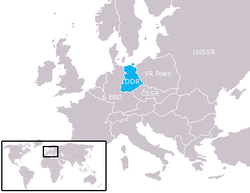 | |||||||||
| Capital | East Berlin | ||||||||
| Common languages | Official: German Unofficial minority languages: Sorbian | ||||||||
| Government | Socialist republic | ||||||||
| Chairman of the Council of State | |||||||||
• 1949–60 | Wilhelm Pieck (President) | ||||||||
• 1960–73 | Walter Ulbricht | ||||||||
• 1973–76 | Willi Stoph | ||||||||
• 1976–89 | Erich Honecker | ||||||||
• 1989 | Egon Krenz | ||||||||
• 1989–90 | Manfred Gerlach | ||||||||
• 1990 | Sabine Bergmann-Pohl | ||||||||
| Chairman of the Council of Ministers | |||||||||
• 1949–64 | Otto Grotewohl | ||||||||
• 1964–73 | Willi Stoph | ||||||||
• 1973–76 | Horst Sindermann | ||||||||
• 1976–89 | Willi Stoph | ||||||||
• 1989–90 | Hans Modrow | ||||||||
• 1990 | Lothar de Maizière | ||||||||
| Legislature | Volkskammer | ||||||||
| Historical era | Cold War | ||||||||
| 7 October 1949 | |||||||||
| 25 September 1990 | |||||||||
• German reunification | 3 October 1990 | ||||||||
| Area | |||||||||
| 1990 | 108,333 km2 (41,828 sq mi) | ||||||||
| Population | |||||||||
• 1990 | 16,111,000 | ||||||||
| Currency | Mark der DDR (M) until 30 June 1990, named: 1948–64 Deutsche Mark (DM) 1964–67 Mark der Deutschen Notenbank (MDN) Deutsche Mark (DM) as of 1 July 1990 | ||||||||
| Calling code | 37 | ||||||||
| Internet TLD | .dd1 | ||||||||
| |||||||||
| Today part of | |||||||||
1 Although .dd was reserved as corresponding ISO code for East Germany, it was not entered to the root before the country was disestablished.[1] 2 Country code +37 was withdrawn in 1992; the numbers range was divided into ten new country codes, re-allocated among several post-Soviet states and European microstates. | |||||||||
The German Democratic Republic (GDR; German: Deutsche Demokratische Republik or DDR), informally called East Germany by the West, was the socialist state established in 1949 in the Soviet zone of occupied Germany and in the East Berlin portion of the Allied-occupied capital city. The German Democratic Republic, which consisted geographically of northeast Germany rather than all of eastern Germany, had an area of 107,771 km2. (41,610 mi.2), bordering Czechoslovakia in the south, West Germany (officially: Federal Republic of Germany) in the south and west, the Baltic Sea to the north, and Poland in the east.
At German reunification, on October 3, 1990, the Länder (states) of East Germany were integrated as new federal states to the Federal Republic of Germany (FRG). Moreover, the German Democratic Republic was disestablished after the Communist government, of the Socialist Unity Party of Germany (SED), lost the general election on March 18, 1990, and thus its parliamentary majority in the Volkskammer (People’s Chamber); subsequently, on August 23, 1990, the Volkskammer re-established the five pre-war states — Brandenburg, Mecklenburg-Vorpommern, Saxony, Saxony-Anhalt, and Thuringia (disestablished in 1952) — for the reunification of East Germany to West Germany.
Naming conventions
The official name was Deutsche Demokratische Republik (German Democratic Republic), usually abbreviated as DDR (GDR). Both terms were used in East Germany with an increasing emphasis on the abbreviated name, especially since East Germany considered West Germans and West Berliners as foreigners following its second constitution in 1968.
Ostzone (Eastern Zone) or Soviet Zone were two surrogate names for East Germany that were often used colloquially. [citation needed] The different names used to describe the German Democratic Republic reflected political positions during the Cold War conflict; for example, many Westerners doubted the political sovereignty and democratic constitution of East Germany. Surrogate name usage for East Germany could thus reveal the political leaning of a person or news source. So the media controlled by the East German government emphasised the use of the official name, DDR, while West Germans, western media and statesmen may have used other names such as Middle Germany, emphasising the location of East Germany in the centre of pre-1937 Germany.
The name, Sowjetische Besatzungszone (Soviet Occupation Zone, often abbreviated to SBZ), was used by those who wanted to indicate that East Germany lacked sovereignty, whereas others used Ostzone or der Osten (English: Eastern Zone or the East), to avoid the actual name of the state. The latter term, because it was based plainly on geographic location, was sometimes also used by East Germans. Some West German media referred to East Germany initially as the SBZ and later consistently named it the so-called "GDR" (sogenannte "DDR"). [citation needed]
However, over time East Germany's abbreviation DDR became colloquial also among most West Germans and West German media.[2] Ostdeutschland (an ambiguous term meaning simultaneously East or Eastern Germany) was not commonly used in East or West German common parlance to refer to the German Democratic Republic, because Ostdeutschland usually referred to the Former eastern territories of Germany.
The term Westdeutschland (West[ern] Germany), when used by West Germans, was almost always a reference to the geographic region of Western Germany, but not to the area within the boundaries of the Federal Republic of Germany. However, this usage was not always consistent, as, for example, West Berliners frequently applied the term Westdeutschland to denote the Federal Republic. [citation needed]
History

In 1955, the USSR declared the Soviet occupation zone — the historic middle portion of Germany — to be the sovereign state named the Deutsche Demokratische Republik (German Democratic Republic, established in 1949), while the Red Army and the Western Allies' occupation forces remained in place, per the tripartite Potsdam Agreement (1945) establishing the Allied Occupation of Germany.
The Communist German Democratic Republic was only established in historic “Mitteldeutschland” (Middle Germany). Former German territories east of the Oder and Neisse rivers, mainly the Prussian provinces of Pomerania, East Prussia, West Prussia, Upper Silesia, Lower Silesia, and the eastern Neumark of Brandenburg were thus detached from Germany. To compensate Poland for the USSR’s annexation of its eastern provinces, at the Yalta Conference (1945), the Allies provincially established Poland’s post-war western border at the Oder-Neisse line. As a result, most of Germany's central territories became the Sowjetische Besatzungszone (SBZ, Soviet Occupation Zone) and with the exception of historic northern East Prussia which went to the U.S.S.R. All other lands east of the Oder–Neisse line were legally put under Polish administration.
Zones of Occupation
In the Yalta and Potsdam conferences, the Allies established their joint military occupation and administration of Germany via the Allied Control Council (ACC), a four-power (US, UK, USSR, France) military government effective until the restoration of German sovereignty. In eastern Germany, the Soviet Occupation Zone (SBZ – Sowjetische Besatzungszone) comprised the five states (Länder) of Mecklenburg-Vorpommern, Brandenburg, Saxony, Saxony-Anhalt, and Thuringia. Disagreements over the policies to be followed in the occupied zones quickly led to a breakdown in co-operation between the four powers, and the Soviets administered their zone without regard to the policies implemented in the other zones. The Soviets withdrew from the ACC in 1948 and subsequently as the other three zones were increasingly unified and granted self-government, the Soviet administration facilitated the development of a separate socialist government in its zone.
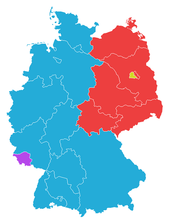
Yet, seven years after the Allies’ Potsdam Agreement to a unified Germany, the USSR, via the Stalin Note (March 10, 1952), proposed German reunification and superpower disengagement from Central Europe, which the three Western Allies (US, France, UK) rejected. Moreover, months later, Soviet leader Josef Stalin, a Communist proponent of reunification, was dead by March 1953. Following suit, Lavrenty Beria, the First Deputy Prime Minister of the USSR, pursued German reunification, but an internal (Party) coup d’ étât deposed him from government in mid-1953, before he could act on the matter. His successor, Nikita Khrushchev, rejected reunification as equivalent to returning East Germany for annexation to the West; hence reunification went unconsidered until the German Democratic Republic collapsed in 1989.

East Germany and the Eastern Bloc diplomatically recognised East Berlin as the capital city of the German Democratic Republic, but the Western Allies disputed said recognition, considering the entire city of Berlin an occupied territory governed by the martial law of the Allied Control Council. In practice, the ACC’s authority was rendered moot by the Cold War, and the East German government ignored the legal restrictions on integration of East Berlin into the GDR.
Abetted by ACC’s weakness, Cold War political conflicts among the Allies over the status of West Berlin provoked the Berlin Blockade (June 24, 1948 – May 12, 1949), the Soviet blockading of all rail-, road-, and waterway traffic to and from West Berlin, and then among the Western Allies' occupation zones of Germany. The Allies countered the Soviets with the Berlin Airlift (1948–49) of food, fuel, and supplies to keep West Berlin alive.
Partition and establishment
| History of Germany |
|---|
 |
In 1946, the Communist Party of Germany (Kommunistische Partei Deutschlands — KPD) and the Social Democratic Party of Germany (Sozialdemokratische Partei Deutschlands — SPD) merged to form the Socialist Unity Party of Germany (SED — Sozialistische Einheitspartei Deutschlands) (April 21, 1945), which then won the elections of 1946, with Soviet propaganda about the Nazi and fascist pasts of non-Communist parties. Being a Marxist-Leninist political party, the SED’s government nationalised infrastructure and industrial plants.

In 1948, the German Economic Commission (Deutsche Wirtschaftskomission—DWK) under its chairman Heinrich Rau assumed administrative authority in the Soviet occupation zone, thus becoming the predecessor of an East German government. (Weitz 1997, p. 350)
On October 7, 1949, the SED established the Deutsche Demokratische Republik (German Democratic Republic — GDR), based upon a socialist political constitution establishing its control of the anti-fascist National Front of the German Democratic Republic (NF — Nationale Front der Deutschen Demokratischen Republik), an omnibus alliance of every party and mass organisation in East Germany. The NF was established to stand election to the Volkskammer (“People's Chamber”), the East German parliament. The first (and only) President of the German Democratic Republic was Wilhelm Pieck. However, after 1950, the true ruler of East Germany was Walter Ulbricht, the First Secretary of the SED.

On June 16, 1953, workers constructing the new Stalinallee boulevard in East Berlin rioted against a 10 per cent production quota increase. Initially a labour protest, it soon included the general populace, who added their anti-Soviet discontent to the workers’ civil disobedience, and, on June 17, like protests occurred throughout the GDR, involving more than a million people striking in some 700 cities and towns. Fearing anti-communist counter-revolution, on 18 June 1953, the government of the GDR enlisted the Soviet Occupation Forces to aid the Volkspolizei (“People’s Police”) in suppressing the rioters; some fifty people were killed and some 10,000 were jailed.[3] (See Uprising of 1953 in East Germany.)
The German war reparations owed to the USSR impoverished the Soviet Zone of Occupation, and severely weakened the East German economy. In the 1945–46 period, the Red Army confiscated and transported to the USSR approximately 33 per cent of the industrial plants, and, by the early 1950s, had extracted some 10 billion dollars in reparations in agricultural and industrial products.[4]
The reparations-induced poverty of East Germany provoked the Republikflucht (“flight from the republic”) to West Germany, which aggravated the German emigration, continual since the 1940s, from the Soviet zone to the Western Ally zones, further weakening the GDR’s economy. Therefore, by the 1950s, the north–south Inner German border (the innerdeutsche Grenze, established 1 July 1945), 1,381 km. (841 mi.) from the Baltic Sea to the Czechoslovak Socialist Republic, was closed. Western economic opportunities and little political freedom in East Germany (viz. the Stasi) induced a “brain drain”. In response, the GDR closed the Inner German Border, and, on the night of August 12–13, 1961, East German soldiers began erecting the Berlin Wall.

In 1971, the Soviet leader Leonid Brezhnev instigated the deposition of Walter Ulbricht as head of state of the GDR; Erich Honecker replaced him. Where the Ulbricht government had experimented with liberal reform, the Honecker government increased controls upon the populace of the GDR, and introduced a new East German Constitution wherein the national adjective “German” featured little, and defined the German Democratic Republic as a “republic of workers and peasants”.
Initially, East Germany maintained that it was the only lawful government of Germany. However, from the 1960s onward, East Germany held itself out as a separate country from West Germany, and shared the legacy of the united German state of 1871-1945. West Germany, in contrast, claimed an exclusive mandate for all of Germany. From 1949 to the early 1970s, West Germany maintained that East Germany an illegally constituted state. It argued that the GDR was a Soviet puppet regime and thus illegitimate. Per the Hallstein Doctrine (1955), it also did not diplomatically recognise any country — except the USSR — that recognised East German sovereignty. Yet, in the early 1970s, the Ostpolitik (“Eastern Policy”) of “Change Through Rapprochement” of the pragmatic government of FRG Chancellor Willy Brandt, established normal diplomatic relations with the East Bloc states and the GDR. In the event, the Treaty of Moscow (August 1970), the Treaty of Warsaw (December 1970), the Four Power Agreement on Berlin (September 1971), the Transit Agreement (May 1972), and the Basic Treaty (December 1972) established normal relations between the Germanies, later allowing their integration to the United Nations.
During this time, West Germany adopted the line of "two German states in one German nation." While it respected East Germany's independence, it formally maintained that the GDR was merely a de facto government within a single German nation of which the FRG was the sole representative. For instance, it refused to treat East Germans as foreigners.

The Wende
In 1989, following widespread public anger over the results of local government elections that spring, many citizens applied for exit visas, or left the country illegally. In August 1989 Hungary removed its border restrictions and unsealed its border, and more than 13,000 people left East Germany by crossing the "green" border via Czechoslovakia into Hungary and then on to Austria and West Germany.[5] Many others demonstrated against the ruling party, especially in the city of Leipzig. Kurt Masur, the conductor of the Leipzig Gewandhaus Orchestra, led local negotiations with the government, and held town meetings in the concert hall.[6] The demonstrations eventually led Erich Honecker to resign in October, and he was replaced by a slightly more moderate Communist, Egon Krenz.
On 9 November 1989, a few sections of the Berlin Wall were opened, resulting in thousands of East Germans crossing into West Berlin and West Germany for the first time. Krenz resigned a few days later, and the SED abandoned power shortly afterward. Although there were some limited attempts to create a permanent, democratic East Germany, these were soon overwhelmed by calls for unification with West Germany.
East Germany held its first legitimate elections in March 1990. The winner was a coalition headed by the East German branch of West Germany's Christian Democratic Union, which advocated speedy reunification. After some negotiations (2+4 Talks were held involving the two German states and the former Allied Powers (United States, France, United Kingdom, and the Soviet Union) which led to agreement on the conditions for German unification. The five original East German states that had been abolished in 1952 were recreated. On 3 October 1990, the five states officially joined the Federal Republic of Germany, while East and West Berlin united as a third city-state (in the same manner as Bremen and Hamburg).
Aftermath
The great economic and socio-political inequalities between the former Germanies require government subsidy for the full integration of East Germany to the Federal German Republic.
Politics

| Part of a series on |
| Communism |
|---|
 |
|
|
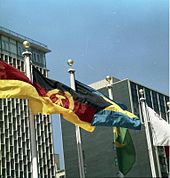
Organization
The ruling political party in East Germany was the Sozialistische Einheitspartei Deutschlands (Socialist Unity Party of Germany, SED). It was created in 1946 through the Soviet-directed merger of the Communist Party of Germany (KPD) and the Social Democratic Party of Germany (SPD) in the Soviet controlled zone.
The Potsdam Agreement committed the Soviets to supporting a democratic form of government in Germany, and, unlike in most Warsaw Pact countries, other, non-communist political parties were allowed. Nevertheless, every political party in the GDR had to register to the National Front of Democratic Germany, an alliance of parties and mass political organisations, including:
- Christlich-Demokratische Union Deutschlands (Christian Democratic Union of Germany, CDU), merged with the West-German CDU after reunification
- Demokratische Bauernpartei Deutschlands (Democratic Farmers' Party of Germany, DBD). This party was of special importance because of farmers' role in the economy. The party merged with the West German CDU after reunification.
- Liberal-Demokratische Partei Deutschlands (Liberal Democratic Party of Germany, LDPD), merged with the West German FDP after reunification.
- Nationaldemokratische Partei Deutschlands (National Democratic Party of Germany, NDPD), merged with the West German FDP after reunification.
Elections took place to the Volkskammer, but were effectively controlled by the SED/state hierarchy, as Hans Modrow has noted. Elections were held in less-than-secret conditions, with voters given the choice of approving or rejecting "unity lists" put forward by the National Front and predetermining the distribution of seats given to the different parties and mass organisations. As was the case in most Communist countries, approval rates of 90 percent or more were routine.
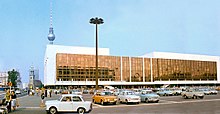
The Volkskammer also included representatives from the mass organisations like the Free German Youth (Freie Deutsche Jugend or FDJ), or the Free German Trade Union Federation. In an attempt to include women in the political life of East Germany, there was a Democratic Women's Federation of Germany, with seats in the Volkskammer.
Important non-parliamentary mass organisations in East German society included the German Gymnastics and Sports Association (Deutscher Turn- und Sportbund or DTSB), and People's Solidarity (Volkssolidarität, an organisation for the elderly). Another society of note was the Society for German-Soviet Friendship.
Following German reunification, the SED was renamed the "Party of Democratic Socialism" (PDS) which subsequently merged with the West German WASG to form the Left Party (Die Linke). The Left Party continues to be a political force in many parts of Germany, albeit drastically less powerful than the SED.
Military
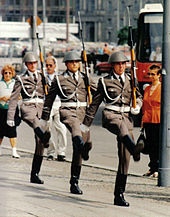
Because Germany was the sharp end of the Russo–American Cold War (1945–91), its four-branch military, the Nationale Volksarmee (National People's Army, NVA) were among the most advanced of the Warsaw Pact; its branches were:
- (i) Army (Landstreitkräfte)
- (ii) Navy (Volksmarine - People's Navy)
- (iii) Air Force–Air Defence (Luftstreitkräfte/Luftverteidigung)
- (iv) GDR Border Troops (Grenztruppen der DDR)
Every man served eighteen months of compulsory military service; for the medically unqualified and the conscientious objector, there were the Baueinheiten, construction units, established in 1964, in response to political pressure by the national Protestant Church upon the GDR’s government. The armed forces of the GDR also possessed paramilitary reserve forces, such as the Kampfgruppen der Arbeiterklasse (Combat Groups of the Working Class), and from the Stasi, the Ministry for State Security (Mfs —Ministerium für Staatssicherheit), the “Schild und Schwert der Partei” (Shield and Sword of the Party).
Administrative districts
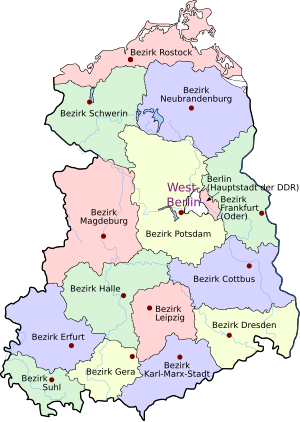
Until 1952, the GDR comprised the East Berlin capital city and the five German states of Mecklenburg-Vorpommern (in 1947 renamed: Mecklenburg), Brandenburg, Saxony-Anhalt, Thuringia, Saxony, their post-war territorial demarcations approximating the pre-war German demarcations of the Middle German Länder (states) and Provinzen (provinces of Prussia). Moreover, the western parts of two provinces, Pomerania and Lower Silesia, although prevailingly annexed by Poland, remained politically integral to the GDR.
The East German Administrative Reform of 1952 disestablished the five states and established 14 Bezirke (districts), named per their capital cities: (i) Rostock, (ii) Neubrandenburg, (iii) Schwerin, (iv) Potsdam, (v) Frankfurt (Oder), (vi) Magdeburg, (vii) Cottbus, (viii) Halle, (ix) Leipzig, (x) Erfurt, (xi) Dresden, (xii) Karl-Marx-Stadt (Chemnitz until 1953 and again in 1990), (xiii) Gera, and (xiv) Suhl; East Berlin was denominated a Bezirk (district) in 1961.
The disestablished Länder (states), re-demarcated as Bezirke (districts), were renamed so: the northern Land (state) Mecklenburg was divided among the Bezirke Rostock, Schwerin, and Neubrandenburg; Brandenburg (containing Berlin) was divided into the Potsdam, Frankfurt (Oder), and Cottbus districts; Saxony-Anhalt was divided into the Halle and Magdeburg districts; the south-western state of Thuringia was divided into the Erfurt, Gera, and Suhl districts; and the south-eastern state of Saxony was divided among the Leipzig, Dresden, and Karl-Marx-Stadt districts.
East Berlin, the capital city of the German Democratic Republic, formed the Bezirk Berlin, the country’s fifteenth district, retaining special legal status until 1968, when the residents voted in approving the new (draft) constitution. Regardless of the city's four-occupying-power-status, the ACC, and diplomatic objections of the Allied governments, the GDR administered the Bezirk Berlin as sovereign territory.

Major cities (1988 populations)
- Berlin, Hauptstadt der DDR (English: Berlin, Capital of the GDR) (1,200,000)
- Leipzig* (556,000)
- Dresden* (520,000)
- Karl-Marx-Stadt* (317,000)
- Magdeburg* (290,000)
- Rostock* (250,000)
- Halle (Saale)* (236,000)
- Erfurt* (215,000)
- Potsdam* (140,000)
- Gera* (131,000)
- Schwerin* (130,000)
- Cottbus* (125,000)
- Zwickau (120,000)
- Jena (107,000)
- Dessau (105,000)
* "Bezirksstadt" (centre of district)
Population
The East German population declined by three million people throughout its forty-one year history, from 19 million in 1948 to 16 million in 1990; of the 1948 population, some 4 million were deported from the lands east of the Oder-Neisse line.[7] This was primarily a result of emigration – about one quarter of East Germans left the country before the Berlin Wall was completed in 1961, and after that time, East Germany had very low birth rates.[8] But in the years before reunification the birth rate in East Germany was much higher than in West Germany,[9] and in general the birth rate per woman was never much lower than in West Germany. This compares starkly with Poland, which increased during that time from 24 million in 1950 (a little more than East Germany) to 38 million (more than twice East Germany's population).
Economy

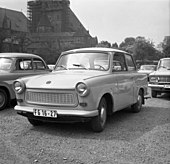
The East German economy began poorly, because of the war reparations owed to the USSR — the Red Army dismantled and transported to Russia the infrastructure and industrial plants of the Soviet Zone of Occupation; by the early 1950s, the reparations were paid in agricultural and industrial products; and Lower Silesia, with its coal mines, and Szczecin, an important natural port, were given to Poland by the decision of Stalin.[4]
The socialist, centrally planned economy of the German Democratic Republic was like that of the USSR. In 1950, the GDR joined the COMECON trade bloc. In 1985, collective (state) enterprises earned 96.7 per cent of the net national income. To ensure stable prices for goods and service, the State paid 80 per cent of basic supply costs. The estimated 1984 per capita income was $9,800 (ca. $21,000 in 2008 dollars). In 1976, the average annual growth of the GDP was approximately 5 per cent.[10]
Notable Communist East German exports were photographic cameras, under the Praktica brand; automobiles, under the Trabant, Wartburg, and the IFA brands; hunting rifles, sextants, and wristwatches.
Until the 1960s, East Germans endured shortages of basic foodstuffs such as sugar and coffee; while coffee was expensive (ca. 1US$ for 200g), yet bread rolls cost less than US1¢[citation needed]. East Germans with friends or relatives in the West (or any access to a hard currency), and the necessary Staatsbank foreign currency account, could afford Western products and export-quality East German products via Intershop. Consumer goods also were available, by post, from the Danish Jauerfood, and Genex companies.
Culture
Music
Artists were expected to sing songs only in German at first[citation needed], which changed with the end of the sixties. This seemed a logical constraint by the Party leaders, but it was unpopular among some young people. Artistic activity was subject to laws censoring anti-socialist tendencies.[citation needed] The band Renft, for example, was prone to political misbehaviour, which eventually led to its split.
The Puhdys and Karat were some of the most popular mainstream bands, managing to hint at critical thoughts in their lyrics without being explicit. Like most mainstream acts, they appeared in popular youth magazines such as Neues Leben and Magazin. Other popular rock bands were Wir, Dean Reed, City, Silly and Pankow. Most of these artists recorded on the state-owned AMIGA label.
Influences from the West were heard, because West German TV and radio could be received in many parts of the East, an exception being Dresden, with its geographical position in the Elbe valley, although limited reception of Western radio was still possible there. The Western influence led to the formation of more "underground" groups with a decisively western-oriented sound. A few of these bands were Die Skeptiker, Die Art and Feeling B. Additionally, hip hop culture reached the ears of the East German youth. With videos such as Beat Street and Wild Style, young East Germans were able to develop a hip hop culture of their own.[11] East Germans accepted hip hop as more than just a music form. The entire street culture surrounding rap entered the region and became an outlet for oppressed youth.[12]
Governmental support of classical music maintained some fifty symphony orchestras. See:
- Thomanerchor (Leipzig)
- Sächsische Staatskapelle (Dresden)
- Berliner Sinfonie Orchester
- Staatsoper Unter den Linden (Berlin)
The birth place of Johann Sebastian Bach (1685–1750), Eisenach, was rendered as a museum about him, featuring more than three hundred instruments, which, in 1980, received some 70,000 visitors. In Leipzig, the Bach archive contains his compositions and correspondence, and recordings of his music.
Theatre

East German theatre was originally dominated by Bertolt Brecht, who brought back many artists out of exile and reopened the Theater am Schiffbauerdamm with his Berliner Ensemble. Alternatively, other influences tried to establish a "Working Class Theatre", played for the working class by the working class.
After Brecht's death, conflicts began to arise between his family (around Helene Weigel) and other artists about Brecht's heritage. Heinz Kahlau, Slatan Dudow, Erwin Geschonneck, Erwin Strittmatter, Peter Hacks, Benno Besson, Peter Palitzsch and Ekkehard Schall were considered to be among Bertolt Brecht's scholars and followers.
In the 1950s the Swiss director Benno Besson with the Deutsches Theater successfully toured Europe and Asia including Japan with The Dragon by Jewgenij Schwarz. In the 1960s, he became the Intendant of the Volksbühne often working with Heiner Müller.
After 1975 many artists left the GDR due to increasing censorship. A parallel theatre scene sprung up, creating theatre "outside of Berlin" in which artists played at provincial theatres. For example Peter Sodann founded the Neues Theater in Halle/Saale and Frank Castorf at the theater Anklam.
Theatre and cabaret had high status in the GDR, which allowed it to be very pro-active. This often brought it into confrontation with the State. Benno Besson once said, "In contrast to artists in the west, they took us seriously, we had a bearing."
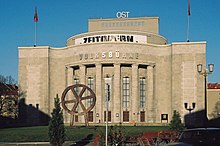
Important theatres:
Cinema
The prolific cinema of East Germany was headed by the DEFA,[17] Deutsche Film AG, which was subdivided in different local groups, for example Gruppe Berlin, Gruppe Babelsberg or Gruppe Johannisthal, where the local teams shot and produced films. Besides folksy movies, the movie-industry became known worldwide for its productions, especially children's movies (Das kalte Herz, film versions of the Brothers Grimm fairy tales and modern productions such as Das Schulgespenst).
Frank Beyer's Jakob der Lügner (Jacob the Liar), about persecution of Jews in the Third Reich, and Fünf Patronenhülsen (Five Cartridges), about resistance against fascism, became internationally famous.
Films about quotidian life, such as Die Legende von Paul und Paula, by Heiner Carow, and Solo Sunny, directed by Konrad Wolf and Wolfgang Kohlhaase, were very popular.
The film industry was remarkable for its production of Ostern, or Western-like movies. Indians in these films often took the role of displaced people who fight for their rights, in contrast to the American westerns of the time, where Indians were often either not mentioned at all or are portrayed as the villains. Yugoslavians were often cast as the Indians, due to the small number of American Indians in eastern Europe. Gojko Mitić was well-known in these roles, often playing the righteous, kindhearted and charming chief (Die Söhne der großen Bärin directed by Josef Mach). He became an honorary Sioux chief when he visited the United States in the 1990s, and the television crew accompanying him showed the tribe one of his movies. American actor and singer Dean Reed, an expatriate who lived in East Germany, also starred in several films. These films were part of the phenomenon of Europe producing alternative films about the colonization of America. See also Spaghetti Western and the West German Winnetou films (adaptations of novels of Karl May).
Because of censorship a certain number of very remarkable movies were forbidden at this time and reissued after the Wende in 1990. Examples are Spur der Steine (directed by Frank Beyer) and Der geteilte Himmel (directed by Konrad Wolf).
Cinemas in the GDR also showed foreign films. Czechoslovak and Polish productions were more common, but certain western movies were also shown, though the numbers were limited because it cost foreign exchange to buy the licences. Further, movies representing or glorifying capitalistic ideology were not bought. Comedies enjoyed great popularity, such as the Danish Olsen Gang or movies with the French comedian Louis de Funès.
Since the fall of the Wall, several movies depicting life in the GDR have been critically acclaimed including an Academy Award.[18] Some of the most notable would be Good Bye Lenin! by Wolfgang Becker, Das Leben der Anderen (The Lives of Others) by Florian Henckel von Donnersmarck and Alles auf Zucker! (Go for Zucker) by Dani Levi. Each film is heavily infused with cultural nuances unique to life in the GDR.
Sport
East Germany was very successful in the sports of bicycling, weight-lifting, swimming, track and field, boxing, ice skating, and winter sports. The success is attributed to the leadership of Dr. Manfred Hoeppner which started in the late 1960s.
Another supporting reason was anabolic steroid doping, which has been the most detected doping substances in IOC-accredited laboratories for many years[19][20] and is now banned by all major sporting bodies. It allowed East Germany, with its small population, to become a world leader in the following two decades, winning a large number of Olympic and world gold medals and records.[21]
Another factor for success was the furtherance-system for young people in GDR. When some children were aged around 6 until 10 years old (or older) sport-teachers at school were encouraged to look for certain talents in every pupil. For older pupils it was possible to attend grammar-schools with a focus on sports (for example sailing, football and swimming). This policy was also used for talented pupils with regard to music or mathematics.
Sports clubs were highly subsidized, especially sports in which it was possible to get international fame. For example, the major leagues for ice hockey and basketball just included each 2 teams (excluding the school and university sport), though a lack of popular interest in both ice hockey and basketball was and is common across the whole of Europe, whether communist or not. Football (soccer) was the most popular sport. Club football sides like Dynamo Dresden, 1. FC Magdeburg, FC Carl Zeiss Jena, 1. FC Lokomotive Leipzig and BFC Dynamo had successes in European competition. Many East German players such as Matthias Sammer and Ulf Kirsten became integral parts of the reunified national football team. Other sports enjoyed great popularity like figure skating, especially because of sportswomen like Katarina Witt.
- Athletes
- Uwe Ampler, racing bicyclist
- Karin Büttner-Janz, gymnast
- Ernst Degner, racing motorcyclist
- Thomas Doll, footballer
- Heike Drechsler, athlete
- Mikhail Grabovski, hockey player
- Marita Koch, athlete
- Olaf Ludwig, racing bicyclist
- Uwe Raab, racing bicyclist
- Jürgen Sparwasser, footballer
- Jens Weissflog, skier
- Katarina Witt, ice skater
- Track-suit diplomacy
The East and the West also competed via sport; GDR athletes dominated several Olympic sports. Of special interest was the only football match between the Federal Republic of Germany and the German Democratic Republic, a first-round match during the 1974 FIFA World Cup, which the East won 1-0, although West Germany, the host, was the eventual champion.
Philately


Television and radio
Television and radio in East Germany were state controlled; the Rundfunk der DDR was the official radio broadcasting organisation from 1952 until German reunification. The organization was based in the Funkhaus Nalepastraße in East Berlin. Deutscher Fernsehfunk (DFF), from 1972–1990 known as Fernsehen der DDR or DDR-FS, was the state television broadcaster from 1952. Reception of Western radio (and even television) broadcasts was widespread.[22]
Telecommunications
By the mid-1980s, East Germany possessed a well-developed communications system. There were approximately 3.6 million telephones in usage (21.8 for every 100 inhabitants), and 16,476 Telex stations. Both of these networks were run by the Deutsche Post der DDR (East German Post Office). East Germany was assigned telephone country code 37; in 1991, several months after reunification, East German telephone exchanges were incorporated into country code 49.
An unusual feature of the telephone network was that in most cases, direct dialing for long distance calls was not possible. Although area codes were assigned to all major towns and cities, they were only used for switching international calls. Instead, each location had its own list of dialling codes - with shorter codes for local calls, and longer codes for long distance calls. This was due to the way the calls were routed over the trunk network. After reunification, the existing network was largely replaced, and area codes and dialling became standardised.
In 1976 East Germany inaugurated the operation of a ground-based radio station at Fürstenwalde for the purpose of relaying and receiving communications from Soviet satellites, and to serve as a participant in the international telecommunications organization established by the Soviet government, Intersputnik.
Holidays
| Date | English Name | German Name | Remarks |
|---|---|---|---|
| 1 January | New Year's Day | Neujahr | |
| Moveable feast | Good Friday | Karfreitag | |
| Moveable feast | Easter Sunday | Ostersonntag | |
| Moveable feast | Easter Monday | Ostermontag | Was not an official holiday after 1967. |
| 1 May | May Day | Tag der Arbeit | International Workers' Day |
| 8 May | Victory in Europe Day | Tag der Befreiung | The translation means "Day of Liberation" |
| Moveable feast | Father's Day / Ascension Day | Vatertag / Christi Himmelfahrt | Thursday after the 5th Sunday after Easter. Was not an official holiday after 1967. |
| Moveable feast | Whitmonday | Pfingstmontag | 50 days after Easter Sunday |
| 7 October | Republic Day | Tag der Republik | National holiday |
| Moveable feast | Day of Repentance and Prayer | Buß- und Bettag | Penultimate Wednesday before the fourth Sunday before December 25. Was not an official holiday after 1967. |
| 25 December | First Day of Christmas | 1. Weihnachtsfeiertag | |
| 26 December | Second Day of Christmas | 2. Weihnachtsfeiertag |
See also
|
Armed Forces
|
Media
|
Transport
|
Other
|

References
- Thomas A. Baylis, David H Childs and Marilyn Rueschemeyer, eds.; East Germany in Comparative Perspective, Routledge. 1989
- David H Childs, The Fall of the GDR, Longman Personed.co.uk, 2001. ISBN13:9780582315693, ISBN10: 0582315697
- David H Childs & Richard Popplewell, The Stasi: East German Intelligence and Security Service, Palgrave Macmillan Palgrave.com,Amazon.co.uk 1996.
- David H Childs, The GDR: Moscow's German Ally, George Allen & Unwin, 1983. ISBN 0-04-354029-5, 9780043540299.
- David H Childs, The Fall of the GDR, Longman, 2001. ISBN 0-582-31569-7 Amazon.co.uk
- David H Childs, The Two Red Flags: European Social Democracy & Soviet Communism Since 1945, Routledge, 2000. Informaworld.com
- Fulbrook, Mary. The People's State: East German Society from Hitler to Honecker Yale University Press, 2005. 352 pp. ISBN 0-300-10884-2.
- Fulbrook; Mary. Anatomy of a Dictatorship: Inside the GDR, 1949-1989 Oxford University Press, 1995
- William Glenn Gray; Germany's Cold War: The Global Campaign to Isolate East Germany, 1949–1969 University of North Carolina Press. 2003
- Jonathan Grix; The Role of the Masses in the Collapse of the GDR Macmillan, 2000
- Konrad H. Jarausch and Eve Duffy; Dictatorship as Experience: Towards a Socio-Cultural History of the GDR Berghahn Books, 1999
- Andrew I. Port, Conflict and Stability in the German Democratic Republic Cambridge University Press, 2007.
- Weitz, Eric D. (1997). Creating German communism, 1890-1990. Princeton University Press. ISBN 0-691-02594-0.
{{cite book}}: Cite has empty unknown parameter:|coauthors=(help)CS1 maint: ref duplicates default (link) - Jonathan R. Zatlin, The Currency of Socialism - Money and Political Culture in East Germany. Cambridge University Press, 2007 ISBN 0-521-86956-0
Notes

- ^ Top-Level-Domain .DD Information site about .dd in German language
- ^ However, the usage of the abbreviation BRD (FRG) for the West German, Bundesrepublik Deutschland (Federal Republic of Germany), became never accepted in West Germany, since it was considered a political statement. Thus BRD (FRG) was a term used by East Germans, or it might have been used by West Germans who held a pro-East German view. Colloquially, West Germans called West Germany simply Germany, or, alternatively, Bundesrepublik or Bundesgebiet (federal republic, or federal territory, respectively), referring to the country and Bundesbürger (federal citizen[s]) for its citizens, with the adjective, bundesdeutsch (federally German).
- ^ East Berlin 17 June 1953: Stones Against Tanks, Deutsche Welle, Accessed 16-May-2007
- ^ a b Norman M. Naimark. The Russians in Germany: A History of the Soviet Zone of Occupation, 1945-1949. Harvard University Press, 1995. ISBN 0-674-78405-7 pp. 167-9
- ^ The Berlin Wall (1961–89) German Notes. Retrieved 2006-10-24.
- ^ Darnton, Robert, Berlin Journal (New York, 1992, W.W. Norton) pp.98–99
- ^ "East Germany: country population". Populstat.info. Retrieved 2010-03-28.
- ^ "Germany Population - Historical Background". Country-studies.com. Retrieved 2010-03-28.
- ^ Destatis.de page 17
- ^ "Business America. (27 February 1989). German Democratic Republic: long history of sustained economic growth continues; 1989 may be an advantageous year to consider this market - Business Outlook Abroad: Current Reports from the Foreign Service". Retrieved 2007-10-02.
- ^ Brown, Timothy S. “‘Keeping it Real’ in a Different ‘Hood: (African-) Americanization and Hip-hop in Germany.” In The Vinyl Ain’t Final: Hip Hop and the Globalization of Black Popular Culture, ed. by Dipannita Basu and Sidney J. Lemelle, pp.137-150. London; A
- ^ Elfein, Dietmar. From Krauts with Atittudes to Turks with Attitudes: Some a Aspects of Hip-Hop History in Germany. pp.225-265 Popular Music vol. 17:3. October 1998.
- ^ "Das BE - ein Theater für Zeitgenossen". Berliner-ensemble.de. Retrieved 2010-03-28.
- ^ "Deutsches Theater: Home". Deutsches-theater.de. Retrieved 2010-03-28.
- ^ "Gorki.de". Gorki.de. Retrieved 2010-03-28.
- ^ "Volksbühne Berlin". Volksbuehne-berlin.de. Retrieved 2010-03-28.
- ^ "DEFA - Stiftung - Home". Defa-stiftung.de. Retrieved 2010-03-28.
- ^ 2006 Academy Award for "The Lives of Others", in 2006.
- ^ Hartgens and Kuipers (2004), p. 515
- ^ Kicman AT; Gower DB (2003). "Anabolic steroids in sport: biochemical, clinical and analytical perspectives". Annals of clinical biochemistry. 40 (Pt 4): 321–56. doi:10.1258/000456303766476977. PMID 12880534.
{{cite journal}}: Cite has empty unknown parameter:|author-name-separator=(help); Unknown parameter|author-separator=ignored (help); Unknown parameter|month=ignored (help) - ^ Tagliabue, John. - "Political Pressure Dismantles East German Sports Machine" - New York Times - 12 February 1991 | Janofsky, Michael. - "OLYMPICS; Coaches Concede That Steroids Fueled East Germany's Success in Swimming" - New York Times - 3 December 1991 | Kirschbaum, Erik. - "East German dope still leaves tracks" - Rediff from Reuters - 15 September 2000 | Ungerleider, Steven (2001). Faust's Gold: Inside The East German Doping Machine. Thomas Dunne Books ISBN 0-312-26977-3 | "Little blue pills and a lot of gold..." - Shorel.com | Culture & Lifestyle: "Sports Doping Statistics Reach Plateau in Germany" - Deutsche Welle - 26 February 2003 | "The East German Doping Machine" - International Swimming Hall of Fame | Culture & Lifestyle: "East Germany's Doping Legacy Returns" - Deutsche Welle - 10 January 2004 | Longman, Jere. - "East German Steroids' Toll: 'They Killed Heidi'" - New York Times - 26 January 2004 | Harding, Luke. - "Forgotten victims of East German doping take their battle to court" - The Guardian - 1 November 2005 | Jackson, Guy. Winning at Any Cost?: "Doping for glory in East Germany" - UNESCO - September 2006 | "Ex-East German athletes compensated for doping" - Associated Press - (c/o ESPN) - 13 December 2006 | "East German doping victims to get compensation" - Associated Press - (c/o CBC Canadian Broadcasting Corporation) - 13 December 2006 | Starcevic, Nesha. - "East German doping victims to get compensation" - Associated Press - (c/o San Diego Union-Tribune) - 13 December 2006 | "Germany completes $4.1M payout to doping victims" - USA Today - 11 October 2007 | "East Germany’s Secret Doping Program" - Secrets of the Dead - Thirteen/WNET - 7 May 2008
- ^ Representing East Germany since unification: from colonization to nostalgia, By Paul Cooke, Berg Publishers, 1 Aug 2005, ISBN 978-1-84520-189-0, page 146. Retrieved from Google Books Jan 25, 2010.
External links
- AHF - Nationale Volksarmee (NVA)
- Template:De icon Auferstanden aus Ruinen
- Template:De icon That was the GDR (in German)
- Translations of propaganda materials from the GDR.
- DDR Museum Berlin - Culture of the GDR
- East Berlin, Past and Present
- Pictures of the GDR 1949–1973
- The Lives of Others official website
- RFE/RL East German Subject Files Open Society Archives, Budapest
- Stamps Catalog of the German Democratic Republic
- East German anthem with English and German lyrics





